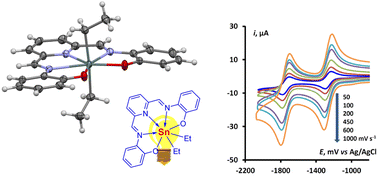Tin coordination derivatives are notable for the availability, safety in use and high stability. This advantage, together with their useful properties, determines the prospects for their use in medicine and materials science. One of the most fundamental characteristics that determine these properties is the location of frontier molecular orbitals and the size of the gap between them. In this work, we synthesized new penta-, hexa-, and hepta-coordinated tin(IV) derivatives from Et2SnO and Schiff bases. The latter were 2-hydroxybenzylidene-hydrazinecarboxamide and –thiosemicarbazone (with 1,10-phenanthroline as an additional ligand), N,N′-bis(2-hydroxybenzylidene)-1,2-phenylenediamine (“Salophen”) and 2,6-pyridinedicarboxaldehyde-bis(2-hydroxyphenyl-imine). The resulting derivatives were characterized by X-ray diffraction analysis. Their redox properties were studied in acetonitrile by cyclic voltammetry, and the results were compared with UV-vis spectroscopy data. The influence of hypercoordination and bond formation with the N-donor on the HOMO and LUMO levels was shown as an effective means of their control and tuning.

